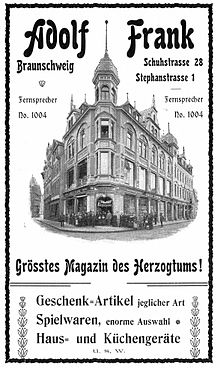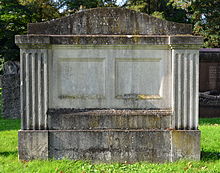Adolf Frank department store
The Adolf Frank department store was founded in Braunschweig in 1889 by the Jewish merchant Adolf Frank (1863–1924) . It was the city's first department store and quickly developed into the largest in the entire Duchy of Braunschweig . It existed until it was forced to sell in 1938.
Company history (1889–1938)
Born in 1863 in Gleidingen , 70 km west of Braunschweig, Adolf Frank founded a haberdashery in 1889 at the age of 26, which soon developed into the first department store in Braunschweig. Its location was Schuhstrasse 28 at the corner of Stephanstrasse 1. The company quickly became the largest department store in the entire Duchy. At its heyday it employed 125 people. The Karstadt department store , which is still located there today, was built in Stephanstraße directly opposite .
Adolf Frank died in Braunschweig in 1924. After his death, the department store was continued by his son Herbert and his son-in-law Gustav-Elias Forstenzer until they had to sell it in the wake of the National Socialist " Aryanizations " in 1938 after massive pressure from the National Socialists . In such cases, the buyer was usually a "deserving party member" of the NSDAP (and possibly owner of a competing company).
The so-called “ department store storm ” can be seen as a harbinger of this development , during which on March 11, 1933 “Frank's large mirror panes were smashed except for one with bricks that were often wrapped in paper ... Then it went with cheers , Continue screaming and shooting to the large Karstadt building just across the street ” . There, too, "the stones [...] flew and the windows clattered [...] Some buyers who [...] came from the Frank department store are said to have been mistreated" . During the further “train through the hat filters” , the Hamburger u. Six large shop windows thrown in Littauer ”. In contrast to the “Karstadt department store, partly owned by Jewish shareholders” , which was “ Aryanised” in March 1933 , the Frank department store remained with its Jewish owners until 1938.
Frank family
Adolf Frank lived in the eastern ring area at Lützowstraße 6 and was with Rosa, nee. Abraham (1865–1935), married. They had three children: Edith (1891–1963), Lucie-Sara (* 1893), later wife of Gustav-Elias Forstenzer and Herbert (* 1895). Herbert Frank was married to Ilse Helmbold (* 1897) and had a daughter named Ilse (* 1926).
During the so-called " Reichskristallnacht " launched by the National Socialists , Herbert Frank and his brother-in-law and co-owner of the Adolf Frank department store, Gustav-Elias Forstenzer, were arrested and temporarily imprisoned in Buchenwald concentration camp . After their surprise release at the beginning of December, both the entire Frank family and the entire Forstenzer family emigrated. The Forstenzer family went to the USA on December 9, 1938 and the Frank family five days later on December 14, 1938, initially to Haiti and in 1940 also to the USA.
"Aryanization" , destruction and the early post-war period
Stöber (1938-1960)
After the November pogroms in 1938, the formerly “Jewish department store” was “ Aryanized ” and the new owner was the Brunswick entrepreneur Karl Stöber (1905–1960). The building was largely destroyed in 1944 during a bomb attack on Braunschweig during the Second World War . In the first post-war years it was gradually restored and continued to serve as a department store. Only in the years of the "second German economic miracle" was a new building erected, which opened in 1956. The new "Kaufhaus Stöber" had the first escalator in Braunschweig. “In addition, a huge Stöber neon sign lit up the night.” Karl Stöber died on February 7, 1960, whereupon the department store again changed hands.
From the "economic miracle" until today
Bilka (1960-1975)
On July 8, 1960, the Bilka department store , a subsidiary of the Hertie department store group , opened its doors. Bilka enlarged the sales area through renovations to 2000 m² and introduced self-service in the food department, which was still rare at the time . During this time, 130 employees were last employed in the department store. In 1975 Bilka closed.
Hertie furniture store (1975–1987)
The Bilka parent company Hertie opened a furniture store in the building in 1975 . With the closure of the Bilka department store, 111 employees had been laid off; As a result, 19 employees were still working in the Hertie furniture store when it opened. After another 12 years, this section of the eventful history also ended and Hertie sold the building.
Kimmich (1987-2006)
Before the Stockstadt-based textile company Kimmich opened its sales branch in Schuhstrasse, extensive renovations were carried out again and the sales area was expanded to 3000 m². The building facade was renovated and the striking "tower" in the entrance area was shortened. In 1997 the house got "a new facade and a projecting glass canopy that spanned the entire corner front". When Kimmich closed in 2006, the fashion house still had a sales area of 1,800 m² and 26 employees. After that, the building stood empty for a while.
New Yorker (since 2007)
In 2007, the Braunschweig clothing company New Yorker acquired the building and has since been rebuilding it with an investment volume of around 13 million euros. The draft for the latest renovation was provided by Professor Karsten K. Krebs, who was already planning several houses for the Braunschweig company. In future, the sales area will be 2500 m², spread over four floors. After the Stöber neon advertisement which went out in 1960, a very conspicuous installation was again attached to the "tower" in the course of the most recent renovation, a 120 m² LED wall over the height of the "four upper floors above the building entrance" on the western "narrow side in the axis of Schuhstrasse ” , according to the new owner of one of “ Europe's largest displays for animations, films and photos ” . The opening date is planned for Easter 2008. 50 employees will then work in the new “business building for young fashion”.
literature
- Reinhard Bein : Jews in Braunschweig 1900–1945 , 2nd edition, Braunschweig 1988
- Bert Bilzer and Richard Moderhack (eds.): BRUNSVICENSIA JUDAICA. Memorial book for the Jewish fellow citizens of the city of Braunschweig 1933–1945 , in: Braunschweiger Werkstücke , Volume 35, Braunschweig 1966
- Garzmann, Schuegraf, Pingel: Braunschweiger Stadtlexikon - supplementary volume , Braunschweig 1996
- Jugendring Braunschweig (Ed.): … And in Braunschweig? Materials and tips for exploring the city 1930–1945 , Braunschweig 1996
Individual evidence
- ↑ a b c Garzmann, Schuegraf, Pingel: Braunschweiger Stadtlexikon - supplementary volume , Braunschweig 1996, p. 47
- ^ Jürgen Hodemacher : Braunschweigs Straßen - their names and their stories, Volume 1: Innenstadt , Cremlingen 1995, p. 309
- ↑ Wolfenbütteler Zeitung of March 13, 1933 (reproduction of the entire article in: Reinhard Bein, Juden in Braunschweig , Braunschweig 1988, p. 52), quoted from: Jugendring Braunschweig (ed.), ... and in Braunschweig? Materials and tips for urban exploration 1930–1945 , Braunschweig 1996, pp. 55/56
- ↑ Jugendring Braunschweig (ed.), ... and in Braunschweig? Materials and tips on urban exploration 1930–1945 , Braunschweig 1996, p. 54
- ↑ a b Bert Bilzer and Richard Moderhack (eds.): BRUNSVICENSIA JUDAICA. Memorial book for the Jewish fellow citizens of the city of Braunschweig 1933–1945 , in: Braunschweiger Werkstück , Volume 35, Braunschweig 1966, p. 165
- ↑ Jörn Stachura: Schuhstraße: In the fashion house the lights go out on April 24, 2006 on newsclick.de (with photos)
- ↑ Jörn Stachura: Kimmich-Aus: 26 employees are waiting for the resignations on April 25, 2006 on newsclick.de
- ↑ a b Ernst-Johann Zauner: Braunschweig gets one of the largest video walls in Europe on September 12, 2007 on newsclick.de (with photos)
- ↑ City of Braunschweig, Department of Urban Planning and Environmental Protection: Communication "Attachment of an advertising system to the building at Schuhstrasse 28 (formerly" Kimmich ")" , printed matter 9115/07 from September 10, 2007, published on ratsinfo.braunschweig.de ( Memento des original from 22. February 2008 in the Internet Archive ) Info: The archive link was inserted automatically and has not yet been checked. Please check the original and archive link according to the instructions and then remove this notice.
Web links
- Braunschweiger Zeitung of April 24, 2006: "Schuhstrasse: The lights go out in the fashion store" (with photos)
- Department store Adolf Frank at vernetztes-gedaechtnis.de (with photos)
- Report on the "warehouse storm" (with photo)
Coordinates: 52 ° 15 ′ 47.5 " N , 10 ° 31 ′ 13.4" E

